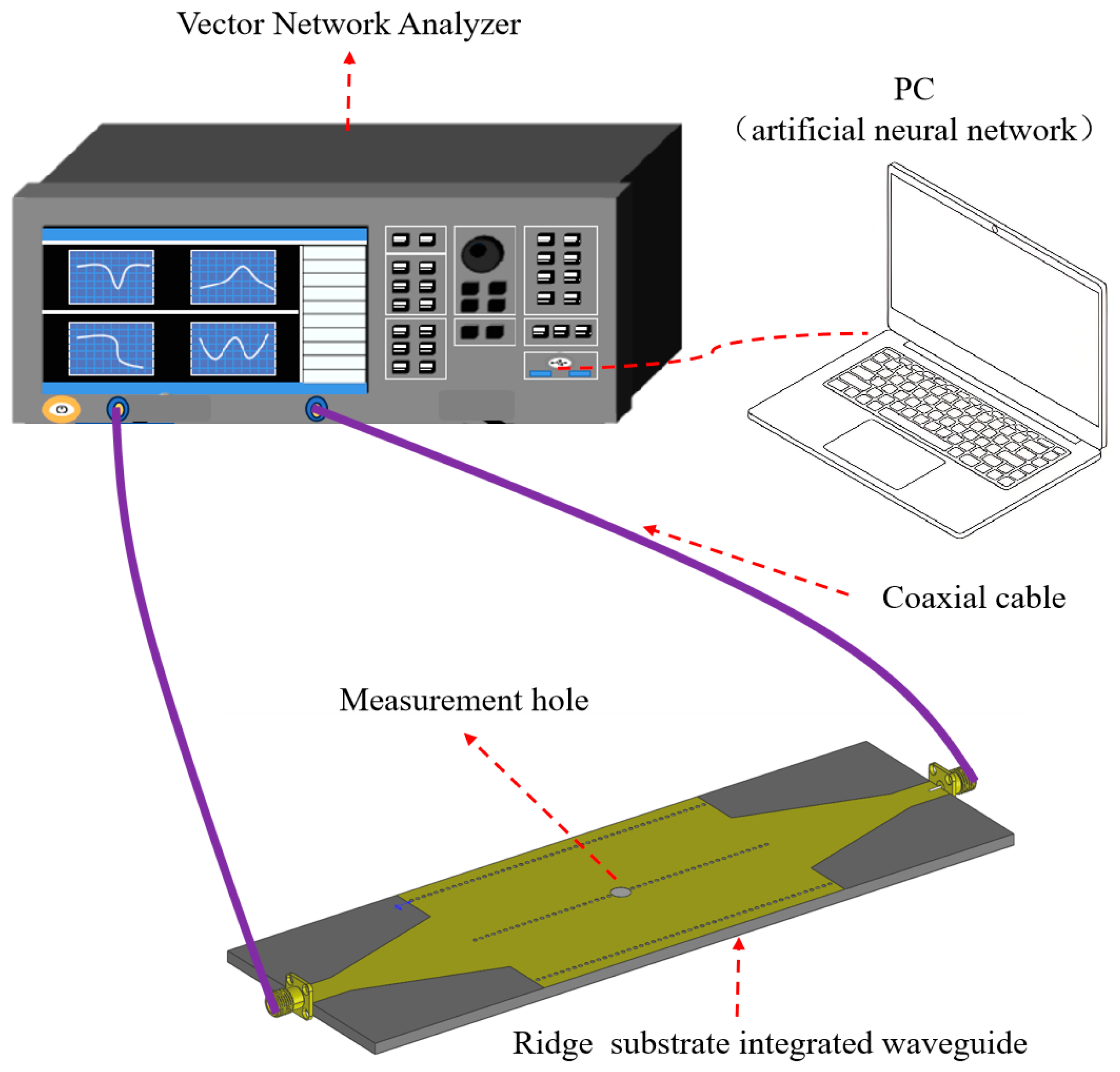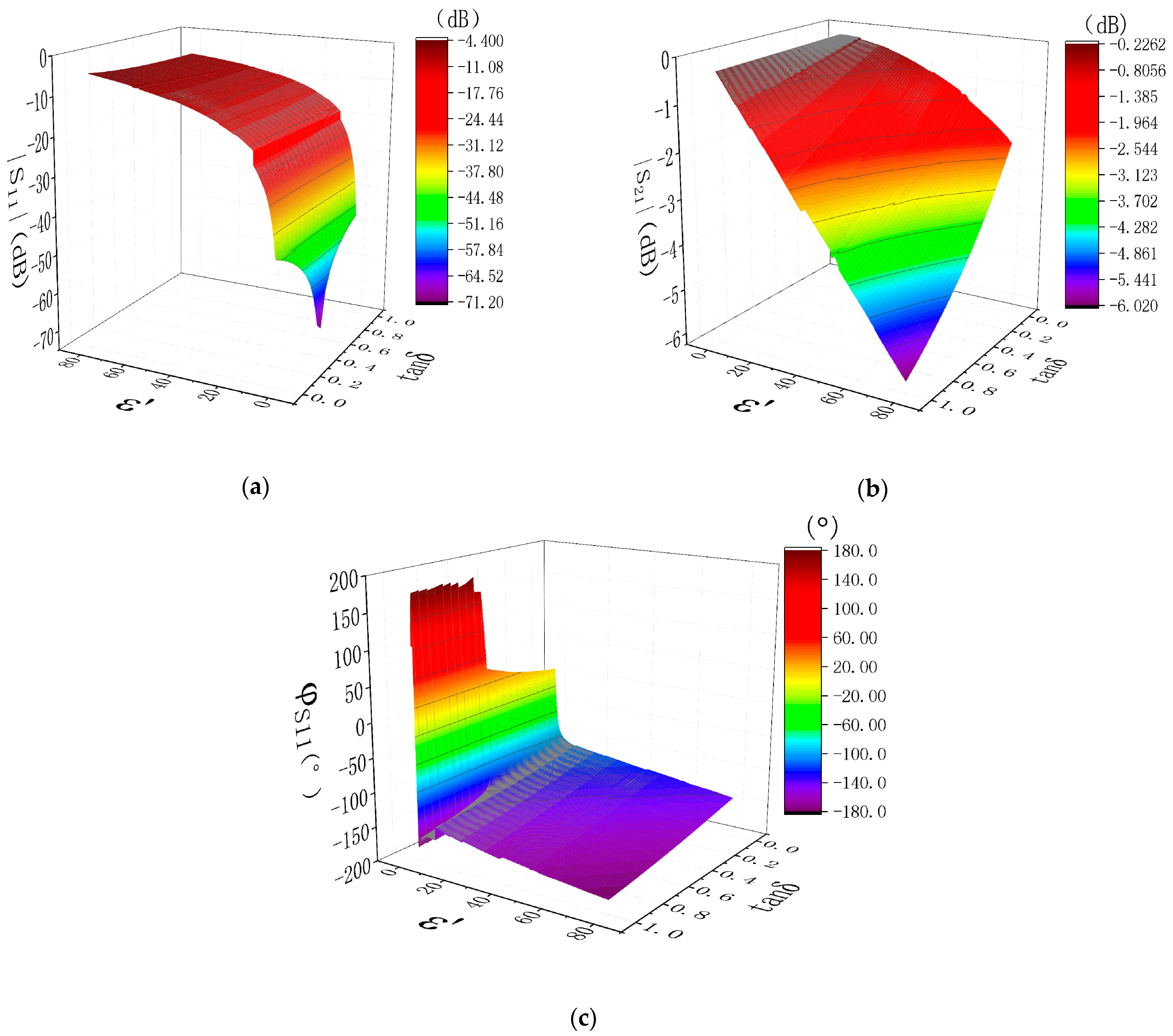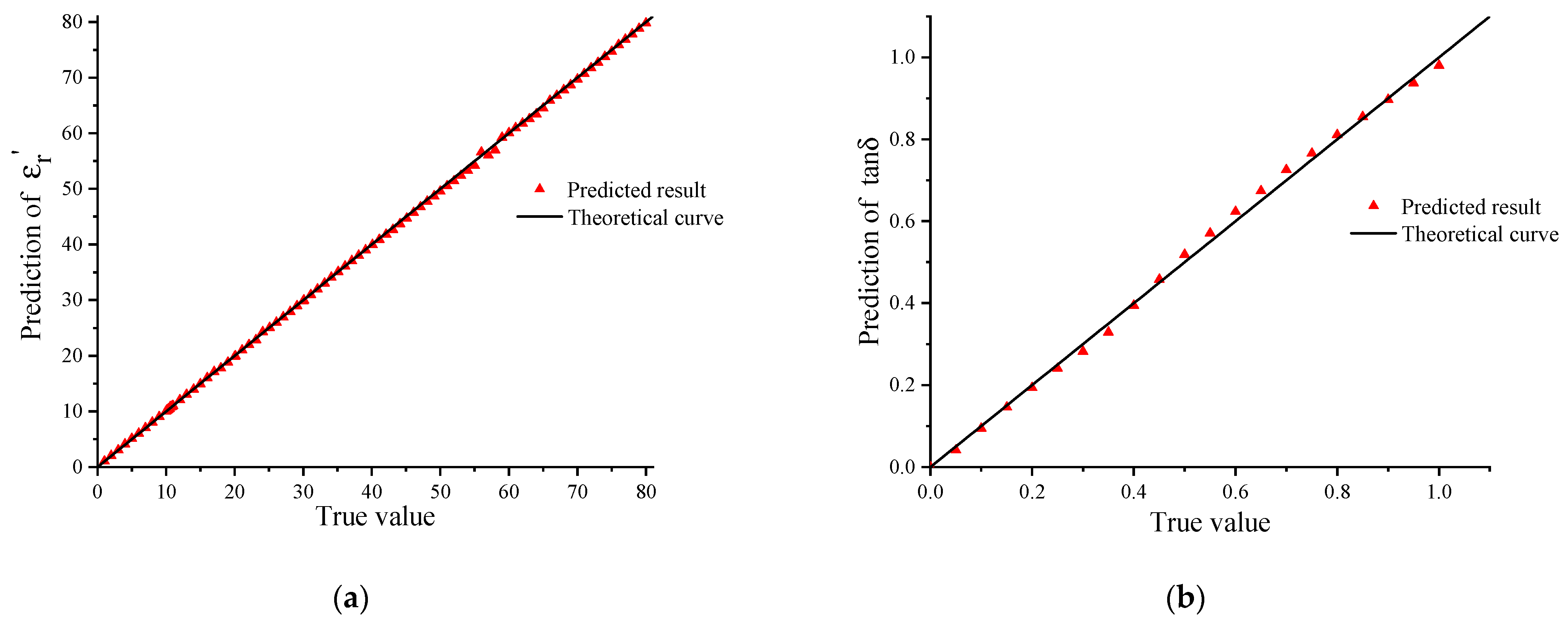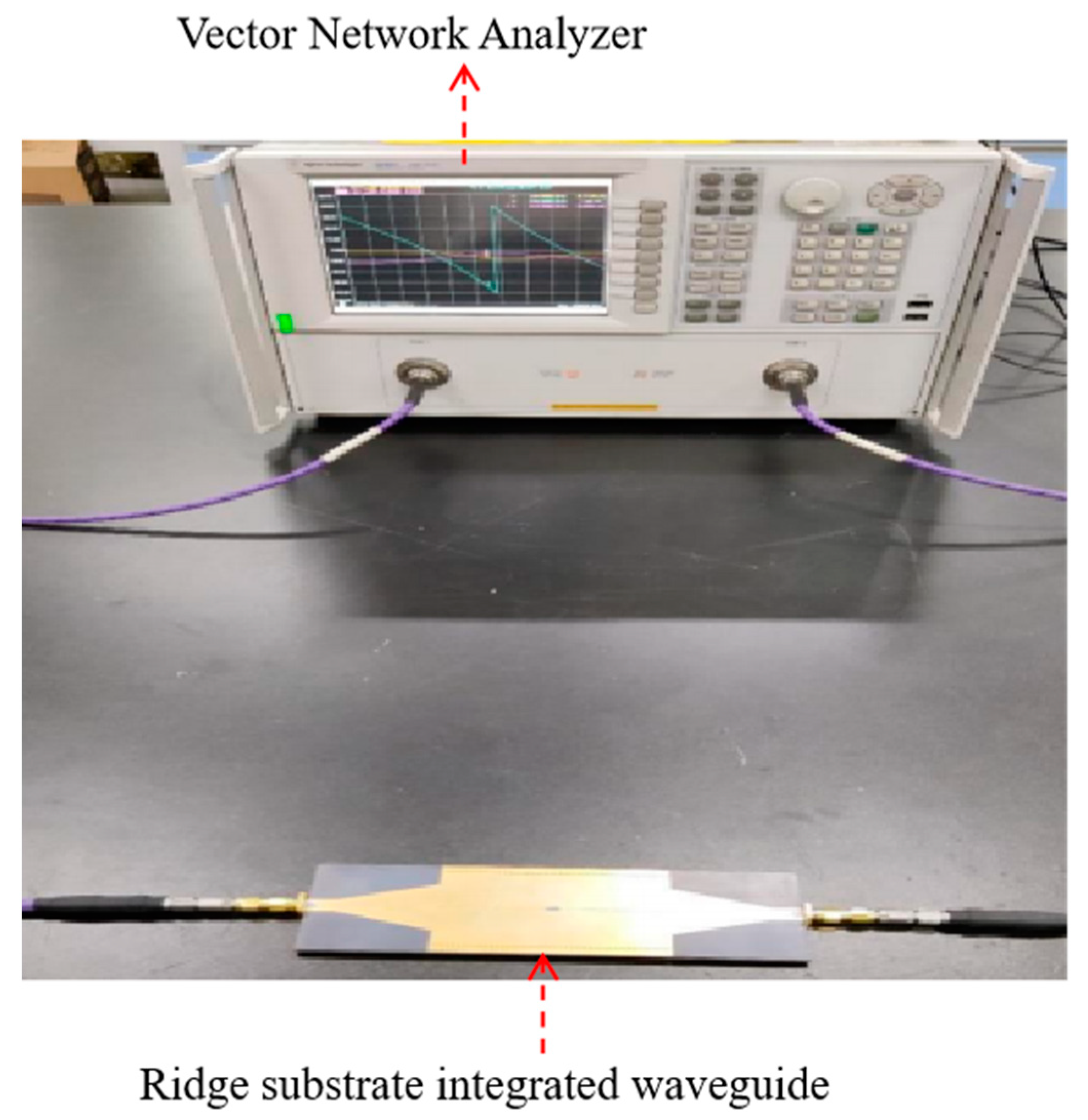A Permittivity Measurement Sensor Based on Ridge Substrate-Integrated Waveguide
Abstract
:1. Introduction
2. Materials and Methods
2.1. Ridge Substrate-Integrated Waveguide Measurement System
2.2. Simulation Parameter Setting and Result Analysis
2.3. Artificial Neural Network Design
3. Results
4. Conclusions
Author Contributions
Funding
Data Availability Statement
Conflicts of Interest
References
- Manh, L.D.; Hung, N.T.; Anh, N.T.; Loi, D.X.; Hoang, N.H. Design of a Compact and High-Efficiency 5.8 GHz Microwave Power Amplifier for Wireless Communication Systems. In Proceedings of the International Conference on Industrial Networks and Intelligent Systems, Hanoi, Vietnam, 22–23 April 2021; Springer: Cham, Switzerland, 2021; pp. 16–24. [Google Scholar]
- Liu, C.; Liao, C.; Peng, Y.; Zhang, W.; Wu, B.; Yang, P. Microwave Sensors and Their Applications in Permittivity Measurement. Sensors 2024, 24, 7696. [Google Scholar] [CrossRef]
- Han, Z.; Li, Y.; Luo, D.H.; Zhao, Q.; Cheng, J.-H.; Wang, J.-H. Structural variations of rice starch affected by constant power microwave treatment. Food Chem. 2021, 359, 129887. [Google Scholar] [CrossRef] [PubMed]
- Zheng, H.; Li, Q.; Ling, Y.; Omran, M.; Gao, L.; Chen, J.; Chen, G. Research on microwave drying technology in the procedure of preparation of V2O5 from ammonium polyvanadate (APV). Adv. Powder Technol. 2021, 5, 2530–2542. [Google Scholar] [CrossRef]
- Pallone, M.J.; Meaney, P.M.; Paulsen, K.D. Surface scanning through a cylindrical tank of coupling fluid for clinical microwave breast imaging exams. Med. Phys. 2012, 39 Pt 1, 3102–3111. [Google Scholar] [CrossRef]
- Liu, J.L.; Xu, J.Y.; Lu, S.; Chen, H. Investigation on dielectric properties and microwave heating efficiencies of various concrete pavements during microwave deicing. Constr. Build. Mater. 2019, 225, 55–66. [Google Scholar] [CrossRef]
- Gonon, P.; Bourdelais, S.; Lesaint, O.; Hong, T.P.; Guuinic, P.; Debruyne, H. Effects of hydrothermal aging on the dielectric properties of epoxy composites. In Proceedings of the 7th International Conference on Properties and Applications of Dielectric Materials, Nagoya, Japan, 1–5 June 2003; IEEE: New York, NY, USA, 2003; Volume 3, pp. 936–939. [Google Scholar]
- Sebastian, T.M. Dielectric Materials for Wireless Communication; Elsevier: Amsterdam, The Netherlands, 2010. [Google Scholar]
- Chen, Q.; Long, Z.; Shinohara, N.; Liu, C. A Substrate Integrated Waveguide Resonator Sensor for Dual-Band Complex Permittivity Measurement. Processes 2022, 10, 708. [Google Scholar] [CrossRef]
- Chen, Q.; Huang, K.; Zeng, X.; Liu, C. Note: Coaxial Apparatus to Measure the Permittivities of Chemical Solutions at Microwave Frequencies. Rev. Sci. Instrum. 2017, 88, 046102. [Google Scholar] [CrossRef]
- Xiong, R.; Hu, Y.; Xia, A.; Huang, K.; Yan, L.; Chen, Q. A High-Temperature and Wide-Permittivity Range Measurement System Based on Ridge Waveguide. Sensors 2025, 25, 541. [Google Scholar] [CrossRef]
- Donchenko, A.V.; Zargano, G.F.; Zemlyakov, V.V.; Kleschenkov, A.B. Measurement of the Complex Dielectric Constant of Materials Based on a Ridge Waveguide. J. Commun. Technol. Electron. 2020, 65, 465–471. [Google Scholar] [CrossRef]
- Tan, Q.; Zhu, H.; Ma, W.; Yang, Y.; Huang, K. High temperature dielectric properties measurement system at 915 MHz based on deep learning. Int. J. RF Microw. Comput. Aided Eng. 2019, 29, e21948. [Google Scholar] [CrossRef]
- Gou, M.; Chen, Q.; Dong, P.; Liu, C.; Huang, K. Design of a Microwave Heating and Permittivity Measurement System Based on Oblique Aperture Ridge Waveguide. Sensors 2023, 23, 4035. [Google Scholar] [CrossRef] [PubMed]
- Hao, H.; Wang, D.; Wang, Z.; Yin, B.; Ruan, W. Design of a high sensitivity microwave sensor for liquid dielectric constant measurement. Sensors 2020, 20, 5598. [Google Scholar] [CrossRef] [PubMed]
- Liu, C.; Tong, F. An SIW Resonator Sensor for Liquid Permittivity Measurements at C Band. IEEE Microw. Wirel. Compon. Lett. 2015, 25, 751–753. [Google Scholar]
- Liu, C.; Pu, Y. A Microstrip Resonator with Slotted Ground Plane for Complex Permittivity Measurements of Liquids. IEEE Microw. Wirel. Compon. Lett. 2008, 18, 257–259. [Google Scholar]
- Bozzi, M.; Georgiadis, A.; Wu, K. Review of substrate integrated waveguide (SIW) circuits and antennas. IET Microw. Antennas Propag. 2011, 5, 909–920. [Google Scholar] [CrossRef]
- Alahnomi, R.A.; Al-Gburi, A.J.A.; Alhegazi, A.; Abd Rashid, W.N.; Mohd Bahar, A.A. Liquid Permittivity Sensing Using Teeth Gear-Circular Substrate Integrated Waveguide. IEEE Sens. J. 2022, 22, 11690–11697. [Google Scholar]
- Soltana, A.; Sadeghzadeha, R.A.; Mohammad-Ali-Nezhad, S. Microwave sensor for liquid classification and permittivity estimation of dielectric materials. Sens. Actuators A. Phys. 2022, 336, 113397. [Google Scholar] [CrossRef]
- Iqbal, A.; Smida, A.; Saraereh, O.A.; Alsafasfeh, Q.H.; Mallat, N.K.; Lee, B.M. Cylindrical Dielectric Resonator Antenna-Based Sensors for Liquid Chemical Detection. Sensors 2019, 19, 1200. [Google Scholar] [CrossRef]
- Hao, H.; Wang, D.; Wang, Z. Design of Substrate-Integrated Waveguide Loading Multiple Complementary Open Resonant Rings (CSRRs) for Dielectric Constant Measurement. Sensors 2020, 20, 857. [Google Scholar] [CrossRef]
- Fesharaki, F.; Akyel, C.; Wu, K. Broadband permittivity measurement of dielectric materials using discontinuity in substrate integrated waveguide. Electron. Lett. 2013, 49, 194–196. [Google Scholar] [CrossRef]
- Loconsole, A.M.; Francione, V.V.; Portosi, V.; Losito, O.; Catalano, M.; di Nisio, A.; Attivissimo, F.; Prudenzano, F. Substrate-Integrated Waveguide Microwave Sensor for Water-in-Diesel Fuel Applications. Appl. Sci. 2021, 11, 10454. [Google Scholar] [CrossRef]
- Moscato, S.; Moro, R.; Pasian, M.; Bozzi, M.; Perregrini, L. Two-Material Ridge Substrate Integrated Waveguide for Ultra-Wideband Applications. IEEE Trans. Microw. Theory Tech. 2015, 63, 3175–3182. [Google Scholar] [CrossRef]
- Angiulli, G.; Versaci, M. Extraction of the Electromagnetic Parameters of a Metamaterial Using the Nicolson–Ross–Weir Method: An Analysis Based on Global Analytic Functions and Riemann Surfaces. Appl. Sci. 2022, 12, 11121. [Google Scholar] [CrossRef]
- Chen, Q.; Huang, K.-M.; Yang, X.; Luo, M.; Zhu, H. An artificial nerve network realization in the measurement of material permittivity. Prog. Electromagn. Res. 2011, 116, 347–361. [Google Scholar] [CrossRef]
- Asteris, P.G.; Mokos, V.G. Concrete compressive strength using artificial neural networks. Neural Comput. Appl. 2020, 32, 11807–11826. [Google Scholar] [CrossRef]
- Li, S.; Wang, S.; Xie, D. Research on radar clutter recognition method based on LSTM. J. Eng. 2019, 19, 6247–6251. [Google Scholar]
- Xu, A.; Chang, H.; Xu, Y.; Li, R.; Li, X.; Zhao, Y. Applying artificial neural networks (ANNs) to solve solid waste-related issues: A critical review. Waste Manag. 2021, 124, 385–402. [Google Scholar] [CrossRef]
- Glorot, X.; Bordes, A.; Bengio, Y. Deep Sparse Rectifier Neural Networks. In Proceedings of the 14th International Conference on Artificial Intelligence and Statistics (AISTATS), Ft. Lauderdale, FL, USA, 11–13 April 2011; pp. 315–323. [Google Scholar]
- Gan, H.Y.; Zhao, W.S.; Liu, Q.; Wang, D.W.; Dong, L.; Wang, G.; Yin, W.Y. Differential Microwave Microfluidic Sensor Based on Microstrip Complementary Split-Ring Resonator (MCSRR) Structure. IEEE Sens. J. 2020, 20, 5876–5884. [Google Scholar] [CrossRef]
- Bonkerud, J.; Zimmermann, C.; Weiser, P.M.; Vines, L.; Monakhov, E.V. On the Permittivity of Titanium Dioxide. Sci. Rep. 2021, 11, 12443. [Google Scholar] [CrossRef]
- Deslandes, D.; Wu, K. Design Consideration and Performance Analysis of Substrate Integrated Waveguide Components. In Proceedings of the European Microwave Conference, Manchester, UK, 10–13 October 2011; IEEE: New York, NY, USA, 2011. [Google Scholar]
- Ainsworth, J. A Numerical Model of the Propagation Characteristics of Multi-layer Ridged Substrate Integrated Waveguide. Ph.D. Thesis, University of Manchester, Manchester, UK, 2012. [Google Scholar]
- Bozzi, M.; Winkler, S.A.; Ke, W. Novel compact and broadband interconnects based on ridge substrate integrated waveguide. In Proceedings of the International Microwave Symposium Digest, Boston, MA, USA, 7–12 June 2009; IEEE: New York, NY, USA, 2009. [Google Scholar]
- Ma, C.; Wang, S.; Zhao, J.; Xiao, X.; Xie, C.; Feng, X. Comparative study on the performance of different machine learning models for predicting the shear strength of RC deep beams. Expert Syst. Appl. 2023, 225, 120649. [Google Scholar]
- User’s Guide & Service Guide 85052D—3.5 mm Economy Calibration Kit. Available online: https://www.keysight.com/us/en/assets/9018-01142/user-manuals/9018-01142.pdf (accessed on 1 June 2024).
- N1501A Dielectric Probe Kit 10 MHz to 50 GHz. Available online: https://www.keysight.com/us/en/assets/7018-04631/technical-overviews/5992-0264.pdf (accessed on 1 June 2024).
- Chen, Y.; Hua, C.; Shen, Z. Circularly Polarized UHF RFID Tag Antenna for Wireless Sensing of Complex Permittivity of Liquids. IEEE Sens. J. 2021, 21, 26746–26753. [Google Scholar] [CrossRef]
- Han, X.; Liu, K.; Zhang, S.; Peng, P.; Fu, C.; Qiao, L.; Ma, Z. CSRR Metamaterial Microwave Sensor for Measuring Dielectric Constants of Solids and Liquids. IEEE Sens. J. 2024, 24, 14167–14176. [Google Scholar] [CrossRef]








| Parameter | Value (mm) |
|---|---|
| 1 | |
| 1.8 | |
| 51.26 | |
| 3.5 | |
| 1.8 | |
| 5 | |
| 1 | |
| 3 | |
| 1 |
| Work | Maximum Relative Errors of ε′ | Measurement Speed | Sample Volume | Machining Complexity | Measurement Method |
|---|---|---|---|---|---|
| [11] | 6.626% | Rapidly | 8.5 mL | Medium | Non-resonant |
| [14] | 9.8% | Real-time | 5 mL | Medium | Non-resonant |
| [40] | 11% | Real-time | 1.8 mL | Low | Resonant |
| [41] | 3.96% | Real-time | <0.1 mL | Low | Resonant |
| This work | 3% | Real-time | <0.1 mL | Low | Non-resonant |
Disclaimer/Publisher’s Note: The statements, opinions and data contained in all publications are solely those of the individual author(s) and contributor(s) and not of MDPI and/or the editor(s). MDPI and/or the editor(s) disclaim responsibility for any injury to people or property resulting from any ideas, methods, instructions or products referred to in the content. |
© 2025 by the authors. Licensee MDPI, Basel, Switzerland. This article is an open access article distributed under the terms and conditions of the Creative Commons Attribution (CC BY) license (https://creativecommons.org/licenses/by/4.0/).
Share and Cite
Chen, H.; Yan, H.; Gou, M.; Hu, K.; Liu, J. A Permittivity Measurement Sensor Based on Ridge Substrate-Integrated Waveguide. Processes 2025, 13, 1347. https://doi.org/10.3390/pr13051347
Chen H, Yan H, Gou M, Hu K, Liu J. A Permittivity Measurement Sensor Based on Ridge Substrate-Integrated Waveguide. Processes. 2025; 13(5):1347. https://doi.org/10.3390/pr13051347
Chicago/Turabian StyleChen, Hu, Han Yan, Mingyi Gou, Kewen Hu, and Ji Liu. 2025. "A Permittivity Measurement Sensor Based on Ridge Substrate-Integrated Waveguide" Processes 13, no. 5: 1347. https://doi.org/10.3390/pr13051347
APA StyleChen, H., Yan, H., Gou, M., Hu, K., & Liu, J. (2025). A Permittivity Measurement Sensor Based on Ridge Substrate-Integrated Waveguide. Processes, 13(5), 1347. https://doi.org/10.3390/pr13051347





